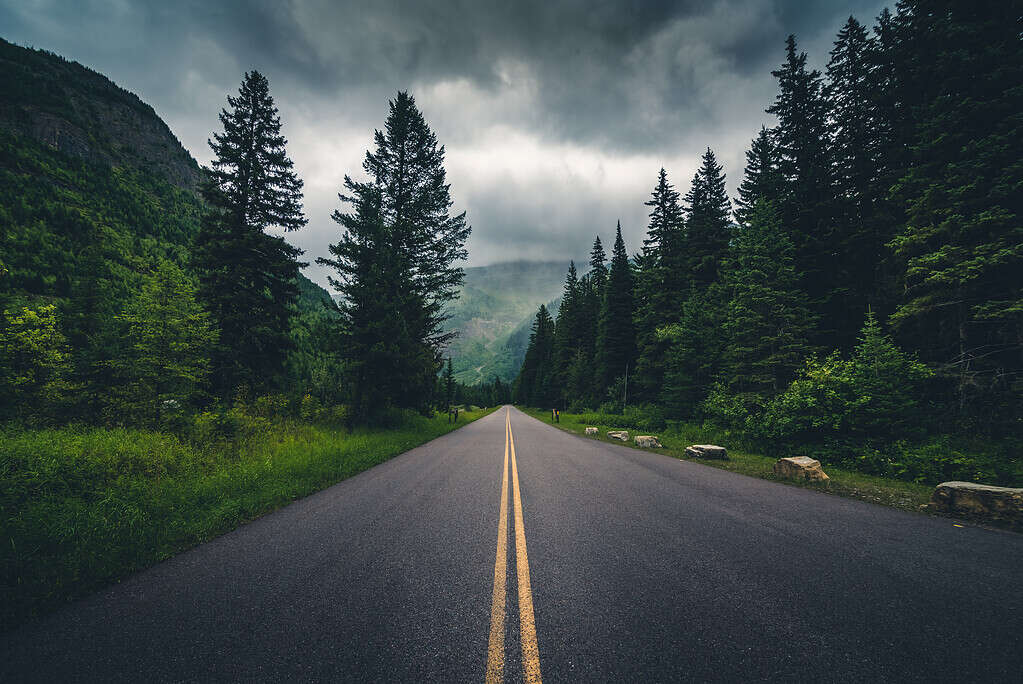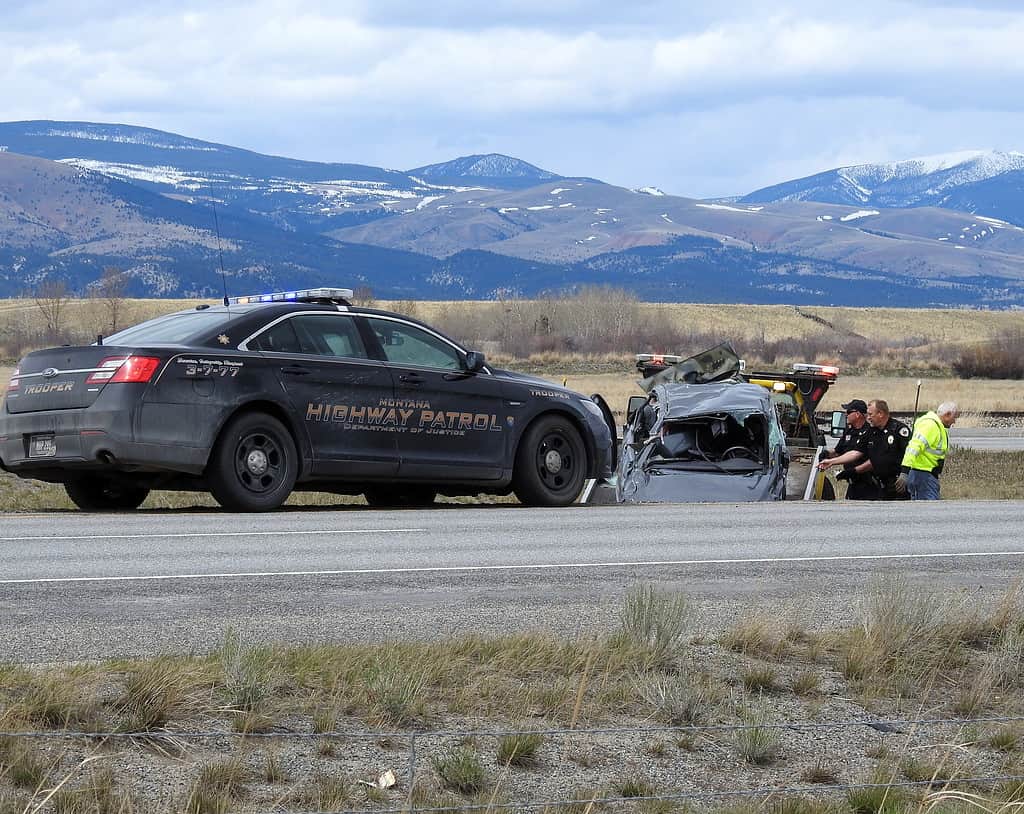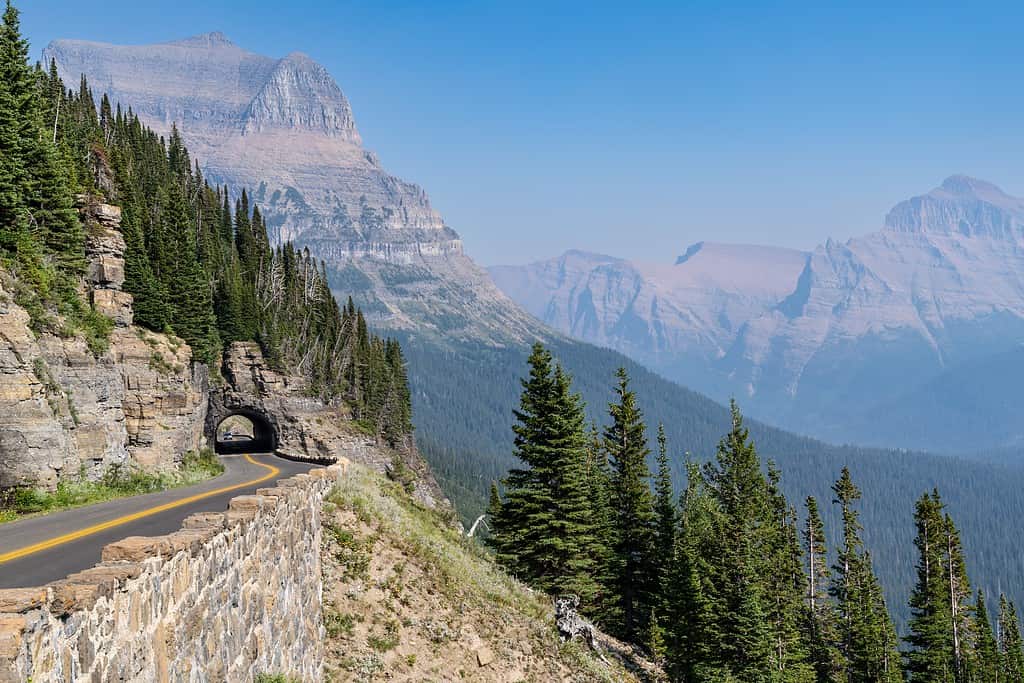As of May 2023, research data revealed that Montana recorded 54 highway fatalities in 2023, showing zero improvement from the 55 deaths during the same period in 2022. Alarmingly, 51% of these fatal accidents were DUI-related, indicating a pressing issue on these difficult paths. The statistics may have changed since May 2023, as data for the entire year has yet to be available.
Evidently, some roads in Montana aren’t as serene as they seem. In this blog post, we’ll explore Montana’s seven most dangerous roads, where adrenaline-charged encounters and life-threatening hazards await even the most seasoned drivers. Join us as we venture into the stories behind these notorious routes and reveal how to navigate them safely.

Montana recorded 54 highway fatalities in 2023 as of May.
©RyanTangPhoto/Shutterstock.com
1. U.S. Highway 2
Montana’s Highway 2 starts in Butte, the county seat of Silver Bow County, and ends in Three Forks, a city in Gallatin County. Nestled along the eastern foothills of the Rocky Mountains, this challenging road stretches for 63 miles (101 km).
Navigating Highway 2 is no walk in the park. It’s filled with numerous twists, turns, and steep inclines. Mother Nature adds to the difficulty, making the road slick and treacherous, particularly during winter. Fatal accidents often result from black ice, blizzards, and strong gusts of wind.
Reaching 6,469 feet (1,972 meters) at Pipestone Pass in Silver Bow County, Highway 2 winds through the picturesque Pioneer Mountains range within Beaverhead-Deerlodge National Forest. Despite its demanding nature, this fully paved road showcases the breathtaking beauty of Montana’s landscape.
Accidents and Fatalities
This lonely road is notorious for its high fatality rate. The Center for Excellence in Rural Safety ranks it among the most dangerous roads in the country. Its remote location means that help is often far away, with victims waiting an average of 80 minutes for emergency services.
Reasons for its Dangerous Reputation
Highway 2’s dangerous reputation stems from various factors. Harsh weather conditions like snowstorms and icy roads make driving treacherous. Moreover, wildlife encounters, like deer darting onto the highway, pose risks for drivers. The lack of guardrails along certain stretches only adds to the peril.
Safety Tips for Driving on Highway 2
To stay safe on this lonesome highway, follow these essential tips:
- Always wear your seatbelt – don’t tempt fate!
- Keep an eye out for wildlife, especially during dawn and dusk.
- Be prepared for sudden weather changes – pack an emergency kit.
- Drive cautiously and maintain a safe distance from other vehicles.
- If you’re tired, pull over and rest – don’t push your luck.
U.S. Highway 2 may be a lonely road, but it’s also dangerous. By staying vigilant and following safety guidelines, you can avoid becoming another statistic on this treacherous stretch of asphalt.
2. U.S. Highway 191
Highway 191, known as the Devil’s Highway, snakes through Arkansas, leaving a mystery trail. Despite its seemingly harmless appearance, danger lurks around every bend. This unassuming stretch of road boasts smooth surfaces, direct interchanges, and an abundance of straight, long sections.
On the downside, this top-notch highway is a hotbed for puzzling accidents each year. Locals often find themselves unable to pinpoint the cause of these hair-raising incidents. The Devil’s Highway holds its cards close to its chest, refusing to reveal its secrets.
Like a wolf in sheep’s clothing, Highway 191 appears harmless but harbors an underlying menace. Travelers, beware, for the seemingly straightforward path may lead you astray.
The dangerous nature of Highway 191 stems from several factors, including numerous sharp curves and the absence of shoulders along the cliffs. These elements contribute to the highway’s treacherous reputation, making it a force to be reckoned with.
To stay safe while driving on Highway 191, consider these safety tips:
- Maintain a careful speed, particularly when approaching sharp turns or driving along cliffside roads.
- Stay focused and alert, as the highway’s appearance can create a false sense of security.
- Keep a safe distance from vehicles ahead, allowing enough space for sudden stops or unforeseen obstacles.
- Check weather conditions before starting your journey, as adverse weather can make the road’s hazards even more dangerous.
- Travel with someone who can help you stay attentive and share the responsibility of navigating the rugged terrain.
- Take regular breaks to avoid fatigue and maintain your focus behind the wheel.
- Be prepared for emergencies by carrying a kit with first aid supplies, a flashlight, and a charged cell phone.
3. Highway 93
Highway 93 stands notorious as one of the most treacherous roads in Montana. This road demands utmost caution from drivers, owing to its numerous risks and hazards.
Stretching from the Canadian border, passing through Missoula, and extending down to Idaho, Highway 93 covers an extensive distance. This long route witnesses a high frequency of fatal accidents, making it one of the deadliest roads in the United States.
The number of animal crossings is the primary factor contributing to Highway 93’s danger. Montana reported over 3,000 wildlife crashes, with Highway 93 being the epicenter. The most dangerous section spans 20 miles, between mileposts 90 and 110, where deer, elk, and bears are frequently spotted crossing the road.
Heavy traffic, poor road conditions, and limited visibility exacerbate the risks on this highway. Drivers must navigate these challenges with care to ensure their safety and the safety of others.
To stay safe on Highway 93, follow these tips:
- Remain vigilant for wildlife, especially near Flathead Lake.
- Obey posted speed limits.
- Keep a safe distance from other vehicles.
4. Interstate 90
Highway 93 in Montana is notorious, but Interstate 90 steals the spotlight as the most dangerous road. I-90 stands out as the deadliest highway in the United States; this infamous title has little to do with its condition or wildlife encounters. Drunk driving is the major reason for the highway’s dangerous status.
The National Highway Traffic Safety Administration has reported an average of five drunk-driving-related deaths per 100,000 people along I-90. Bozeman Pass, situated on Interstate 90, stretches for several miles through the treacherous Montana mountains. Various factors, including high traffic volume, poor visibility, and slippery road conditions make it unsafe for use. To safely navigate Bozeman Pass, please follow these precautions:
- Stay sober and alert when behind the wheel.
- Avoid distractions and maintain focus on the road.
- Stick to speed limits and adjust for weather conditions.
- Wear your seat belt and ensure passengers do likewise.
- Check the forecast and plan for possible road conditions.

I-90 stands out as the deadliest highway in the United States.
©Mark Holloway, CC BY 2.0, via Wikimedia Commons – License
5. U.S. Highway 12
Highway 12, the Lewis and Clark Highway, sits high in Montana’s Bitterroot Range. This treacherous road is one of America’s 15 Best Motorcycling Roads. It is fitted with signs reading “Curves next 99 miles” that promise thrilling rides for daring motorists.
This two-lane highway features sweeping curves and a smooth surface. However, its speed limits of 50 miles-per-hour and limited passing opportunities make it a risky venture. The road entices drivers with gentle turns, lulling them into a false sense of security before throwing sharper curves their way.
Stretching 134 miles from Lolo to Kooskia, this dizzying drive demands full attention. Guardrails are scarce, and sharp turns appear unexpectedly. Services along the route are few and far between.
Nestled in the Nez Perce-Clearwater National Forest, the highway to Lolo Pass was completed in 1962. Allow three hours for this breathtaking journey through meadows, mountain peaks, and forests. As part of the Lewis & Clark Trail, it showcases the stunning beauty of Idaho and Montana’s Rocky Mountains.
Keeping Safe On the Highway
Navigating U.S. Highway 12 requires extra caution and preparation. Consider these additional tips:
- Stay focused: Eliminate distractions like cell phones and loud music to concentrate fully on the road.
- Adjust your driving style: Navigate the curves smoothly and avoid abrupt braking or acceleration.
- Use engine braking: When descending steep slopes, use engine braking to maintain control and reduce wear on your brakes.
- Watch for road signs: Consider warning signs indicating sharp turns, narrow lanes, or other hazards.
- Drive during daylight hours: Visibility is crucial, so plan your trip to avoid driving in darkness or poor visibility conditions.
- Practice defensive driving: Anticipate potential dangers and be ready to react appropriately.
- Inform others of your plans: Let someone know your intended route and estimated arrival time, so they can check on you if necessary.
6. Skalkaho Highway (Montana Highway 38)
Nestled in Montana, the notorious Skalkaho Highway stretches across treacherous terrain. This hazard-filled highway measures a significant length and keeps drivers on their toes.
Skalkaho Highway presents numerous challenges, including unpaved sections, tight turns, and blind corners. These obstacles make the drive a white-knuckle affair, especially for inexperienced motorists.
As the seasons change, so do the road conditions. Due to hazardous circumstances, officials often close the highway during harsh weather, ensuring the safety of travelers.
Despite its dangers, the scenic route offers breathtaking views, including the mesmerizing Skalkaho Falls. For those with a keen eye, a pitstop at Gem Sapphire Mountain, just 40 miles from Hamilton, might unearth hidden treasures.
When embarking on this difficult journey, following safety tips is crucial. Stay alert, maintain a safe distance, and exercise caution when navigating the twists and turns of Skalkaho Highway.
7. Going-to-the-Sun Road
Going-to-the-Sun Road boasts stunning views in Montana’s Glacier National Park. This engineering wonder is a scenic drive like no other. However, it ranks as one of North America’s most challenging roads to snowplow.
The road stretches 50 miles through the Rocky Mountains. It connects West Glacier to St. Mary and is a top motorcycling route. Paved but narrow, it features hairpin turns and breathtaking vistas. Unfortunately, it’s also perilous due to its twists and tight lanes.
Using the Sun Road in Montana is risky for these reasons:
- Frequent rock slides and falling rocks pose additional hazards. Glacier National Park also experiences unpredictable weather, including sudden rainstorms and fog. Consequently, visibility reduces, and roads become slippery.
- Wildlife encounters like deer or bears may cause abrupt braking or swerving. Limited access to medical assistance makes it more challenging to handle emergencies. High elevation at Logan Pass can lead to altitude sickness, affecting drivers’ concentration.
- Seasonal closures due to heavy snowfall and ice accumulation make the road dangerous. Limited cell phone reception hinders communication during emergencies. Additionally, tourist traffic in summer increases the risk of collisions.
- Lastly, some areas have poor visibility (majorly caused by sun glare) that increase accident cases.
Despite these dangers, you can follow certain precautions to ensure a safe and memorable drive through this beautiful landscape. Here are some of them:
- Check vehicle size restrictions.
- Prepare for rock overhangs if your vehicle is over 10 feet in height.
- Be mindful of steep drop-offs and tight curves.
- Use pullouts and viewpoints for extended stops and photos.
- Drive slowly and cautiously, especially around hairpin turns.
- Stay alert and focused on the road.

Going-to-the-Sun Road features hairpin turns and breathtaking vistas.
©melissamn/Shutterstock.com
Alternative Routes and Scenic Byways
Alternative routes and scenic byways offer a safer driving experience while providing breathtaking views.
1. U.S. Route 212 Alternative: Chief Joseph Scenic Byway
Instead of taking the risky U.S. Route 212, opt for Chief Joseph Scenic Byway. This route offers stunning views of mountains and valleys with minimal accidents. It connects Cody, Wyoming, to the Beartooth Highway, allowing you to bypass the most treacherous sections.
2. Safer Route for Going-to-the-Sun Road: Glacier Park’s Outer Loop
Choose Glacier Park’s Outer Loop to avoid the hazards of Going-to-the-Sun Road. This alternative route circles Glacier National Park, providing awe-inspiring vistas without the cliffs and narrow lanes. Explore the park safely while still enjoying its natural beauty.
3. Skalkaho Pass Alternative: Bitterroot Valley Scenic Drive
Bypass the difficult Skalkaho Pass and take the Bitterroot Valley Scenic Drive instead — this picturesque route follows the Bitterroot River, showcasing the valley’s lush forests and rugged mountains. By driving along this route, you can experience Montana’s wilderness without endangering yourself on treacherous roads.
4. Bonus: Montana Scenic Loop
For an all-encompassing journey through Montana’s beauty, consider the Montana Scenic Loop. This 400-mile route combines several scenic byways, avoiding dangerous roads altogether. Discover diverse landscapes, from rolling prairies to snow-capped peaks, as you traverse this safe and captivating route.
Embracing Montana’s Beauty with Caution and Attentiveness
Montana’s varied terrain and ever-changing weather conditions make some roads particularly hazardous. These challenging routes present several obstacles, such as tight bends, steep gradients, and the possibility of avalanches.
Though these roads grant access to beautiful vistas and iconic attractions, travelers must exercise caution and stay alert when navigating the state’s more treacherous routes.
Equipping oneself with appropriate safety gear and adhering to speed limits can greatly minimize the risks of driving on these high-risk roads. Ultimately, enjoying Montana’s picturesque landscapes should be a memorable experience, but safety and attentiveness should always come first
The photo featured at the top of this post is © Sean Xu/Shutterstock.com
Thank you for reading! Have some feedback for us? Contact the AZ Animals editorial team.






